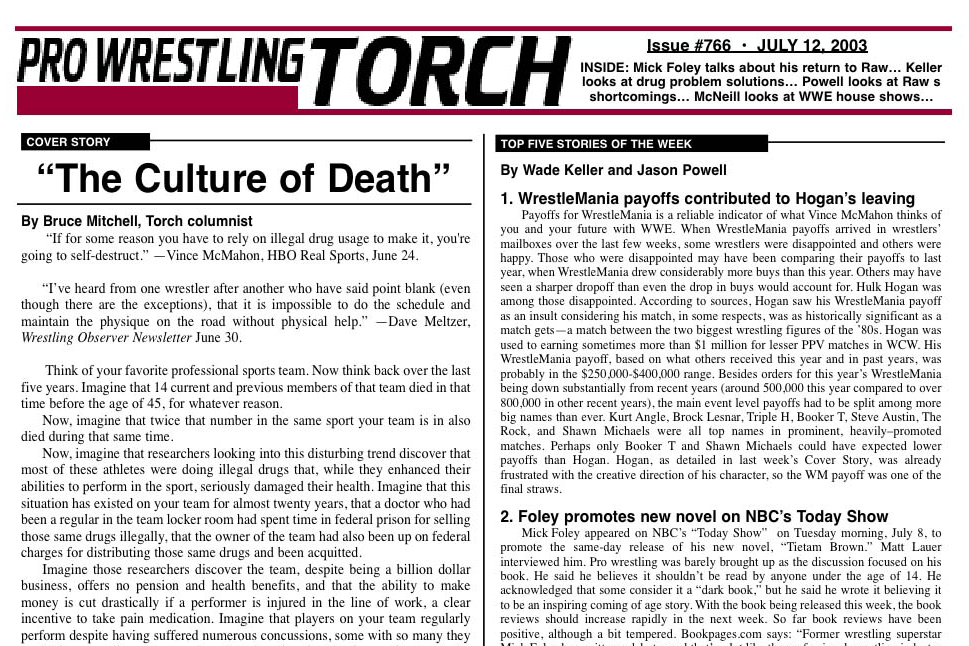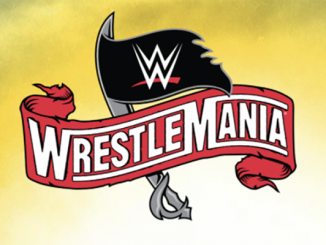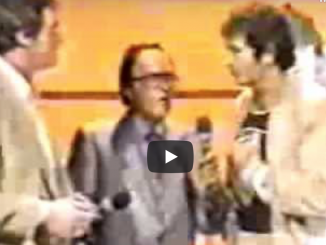
SPOTLIGHTED PODCAST ALERT (YOUR ARTICLE BEGINS A FEW INCHES DOWN)...
This month marks the 25th Anniversary of Bruce Mitchell becoming a Pro Wrestling Torch Newsletter columnist. No single person has influenced the editorial tone and direction of the Torch brand over the years than Bruce, who brought a hard-hitting, supremely well-informed, speak-truth-to-power approach to his writing. He went after sacred cows out of the gate, such as the beloved among “smart fans” (today’s “Internet fans” or “IWC,” I suppose) Eddie Gilbert and Jim Cornette. He also went hard after people in positions of authority and power who were abusing or misusing that power, or just not delivering a worthy product. He has also applauded and paid tribute to the greatest moments and movements in pro wrestling over the last 25 years, with a style of writing that has yet to be matched anywhere, I contend (despite Bill Simmons’s arrogant and uninformed contention last year that no one wrote at a high level about pro wrestling until his “Masked Man” columnist came along).
To celebrate and highlight Bruce’s stellar 25 years of influential and eloquent truth-telling about this fascinating industry, we’ll be featuring a single column from each of the last 25 years each of the first 25 days this month. His long-form columns were a pioneer approach to pro wrestling journalism, and the next 25 years you’ll experience a slice of what it is that has earned Bruce Mitchell widespread recognition within the industry over the years as being “Pro Wrestling’s Most Respected Columnist.” We began on Oct. 1st with his very first column, from Pro Wrestling Torch Newsletter #89 (cover dated Oct. 5, 1990).
Today we feature his column from the July 11, 2003 edition of the Pro Wrestling Torch Weekly Newsletter (#695) titled “Culture of Death” that went in-depth on the mounting issues of pro wrestlers dying much too young from the “pro wrestler lifestyle” and what could be done about it.
NOTE: VIP members can access hundreds of Mitchell columns instantly in the BRUCE MITCHELL LIBRARY here, part of the massive unmatched online archives of insider wrestling coverage from over the past 28 years.
===
HEADLINE: “The Culture of Death”
COVER STORY from JULY 11, 2003
PWTORCH NEWSLETTER #766
By Bruce Mitchell, Torch columnist
“If for some reason you have to rely on illegal drug usage to make it, you’re going to self-destruct.” —Vince McMahon, HBO Real Sports, June 24.
“I’ve heard from one wrestler after another who have said point blank (even though there are the exceptions), that it is impossible to do the schedule and maintain the physique on the road without physical help.” —Dave Meltzer, Wrestling Observer Newsletter June 30.
Think of your favorite professional sports team. Now think back over the last five years. Imagine that 14 current and previous members of that team died in that time before the age of 45, for whatever reason.
Now, imagine that twice that number in the same sport your team is in also died during that same time.
Now, imagine that researchers looking into this disturbing trend discover that most of these athletes were doing illegal drugs that, while they enhanced their abilities to perform in the sport, seriously damaged their health. Imagine that this situation has existed on your team for almost twenty years, that a doctor who had been a regular in the team locker room had spent time in federal prison for selling those same drugs illegally, that the owner of the team had also been up on federal charges for distributing those same drugs and been acquitted.
Imagine those researchers discover the team, despite being a billion dollar business, offers no pension and health benefits, and that the ability to make money is cut drastically if a performer is injured in the line of work, a clear incentive to take pain medication. Imagine that players on your team regularly perform despite having suffered numerous concussions, some with so many they couldn’t even tell you the number. Now imagine that the fans and writers who follow the team closely are neither furious nor grief stricken. Imagine instead that they jump to the team’s defense, that their first reaction is not anger at their favorite performers dying so young, or at the pain their families went through. Their first reaction is to rail at the mainstream perception of their team, to defend their sport at all costs. Even when the star player whom they have loved for years is put in harm’s way, they barely notice, except to complain he doesn’t play more.
Imagine no more.
You’d think the general public, the mainstream media, and the law would be outraged, that the press would be asking hard questions, and there would be calls for congressional investigation. You’d think there might be calls for drastic measures to protect these athletes, either by legislating athletic commissions to monitor their health or starting some sort of independent organization that could advocate for their benefit. You would think that business would be affected, that fans that knew the tragic situation might shy away from watching or spending money until things straightened out.
You’d be wrong.
It’s two weeks after HBO Real Sport’s excellent feature on the alarming death rate of professional wrestlers and we’ve heard every possible excuse, rationalization, spin, and sad side-stepping of responsibility possible for what is the unavoidable 800 pound gorilla of the genre. Most of them have come to the defense of one man, even though the point of feature was the trend of deaths in the professional wrestling industry in general. That man, of course, was Vince McMahon, the CEO of WWE, the most powerful figure in the sport. For some reason many writers thought this multimillionaire with hundreds of hours of television at his disposal was a victim, not the dead wrestlers or the ones still alive who remain at risk.
The following is but a partial list of reasons I’ve either been told or read why Vince McMahon was right to take no responsibility:
•Why, All These Deaths Aren’t Vince McMahon’s Fault
•Nobody told them to become pro wrestlers. Nobody forced them to take those drugs.
•They could quit and get other jobs.
•The numbers are flawed.
•Some of them weren’t in the WWE when they died.
•Junkyard Dog died in a car wreck.
•WWE dropped Curt Hennig before he died.
•WWE dropped Yokozuna before he died.
•WWE dropped Owen Hart before he died.
•Brian Pillman had a bad heart.
•WWE has made several performers go to drug rehab.
•The performers were outlaws to begin with.
•Roddy Piper is an admitted drug addict. Roddy Piper didn’t try to help anybody in the WWE locker room. Roddy Piper is a hypocrite for going back to WWE.
•The schedule for the wrestlers isn’t as bad as it was ten years ago.
•Independent wrestlers are like kids playing ball in the backyard.
•The wrestlers who died weren’t tough enough to cut it.
•WCW was worse. ECW was worse.
•British Bulldog got his back hurt in WCW.
•Yokozuna died from obesity, not drugs.
•If you really study, you can use the illegal drugs pretty safely. Many of the guys just smoke pot to ease the pain.
It’s amazing that a man with so many resources needed so much help to explain himself and the way he runs his business.
Let’s cut the crap. Something is deathly wrong. All that’s left is the question of blame, and maybe what can be done about it all. The first thing that has to be said is that this is a crime of an entire culture. It can hardly be laid at the feet of one man. The blame has to be spread in many directions. Let’s start with the obvious target:
•Vince McMahon and the WWE: This may be a crime of culture, but Vince McMahon had more to do than any other person with creating that culture. It was McMahon, in 1984, who made two dramatic moves that changed professional wrestling forever.
First, he had the business acumen to take his company national and open up revenue streams for performers that had never been available. One of the effects of doing that was that his competitors couldn’t keep up, the number of jobs for wrestlers shrank even as they became more lucrative, and the competition for the remaining spots became much more fierce.
Second, he changed the way both the general public and paying wrestling fans thought a wrestler should look, from pot-bellied ex-football players to the steroid built body, in the words of Harvard researcher Dr. Harrison Pope, “an unnatural creation that’s more male than male.” (ESPN The Magazine, July 7). In the ’80s, Dusty Rhodes and Greg Gagne were on their way out, Hulk Hogan and Lex Luger were in.
Insiders like “Superstar” Billy Graham, whose tye-dyed musclehead look as WWF Champion McMahon loved even before he took over the company from his father, estimated ten years ago fully 80 to 90 percent of the wrestlers in the WWF were using steroids. (After several years in poverty, suffering the horrific side effects of his own use of muscle enhancers, Graham was welcomed back into the WWE family with the announcement that his autobiography would be published under company auspices.) WWF house shows of the time, between the body expectations and the brutal travel schedule Roddy Piper described on “Real Sports,” became little more than unending personal appearance tours with a minimum of workrate. The horrendous grind of never-ending travel became, as McMahon said it best, a “Wild West” of alcohol, steroids, cocaine, and pain pills.
While other companies, specifically Jim Crockett Promotions, followed the trend, there were still spots available for smaller wrestlers who made up for their lack of muscle mass with talent in the ring. JCP wrestlers also ran a national gauntlet, but along with their drug users and abusers were those who survived with fewer drugs to ease their way.
Things moved fast from the late ’80s on through the ’90s. Turner Broadcasting bought the failing JCP. The first drug scandal hit with McMahon’s indictment, trial, and subsequent acquittal on distribution of steroid charges. Much of the uncontradicted testimony in that trial made public for the first time what had been carefully hidden, and for good reason. In the aftermath, McMahon was forced to implement extensive drug testing of his performers.
TBS and WCW’s new wrestling head Eric Bischoff saw a wounded WWF filled with Superstars suspicious of the new policy who were more than happy to head to a new Wild West of guaranteed big money contracts, with half the required dates. Led by Hulk Hogan, many of McMahon’s stars famously did just that. The war was on. One of the first casualties was the WWF drug testing policy.
Another important casualty was WWF’s trademark lack of workrate in favor of the unreal bodies. McMahon had no choice but to go with smaller wrestlers who could work on top such as Bret Hart and Shawn Michaels, after trying Hulk Hogan, Lex Luger, Diesel, and Yokozuna. Yokozuna was told to add 150 pounds to his 400 pound frame to become a super-monster. Thanks to WCW adding cruiserweight and international stars who raised the level of workrate substantially, and ECW doing the same and ratcheting up the violence quotient beside, the WWF had to change.
It did. Thanks to the wrestling war, WWE adopted the highest level of workrate in its history. The entire industry’s pace of spots, chairshots, table and ladder bumps, dives, and body–battering bumps increased exponentially. So did the motivation for performers to take a cornucopia of pain killers. This opened the door to performers with more than just “the look,” but the price that had to be paid physically was just as high in other ways.
The bill came due for the ’80s generation even as the pressure of the wrestling war was chewing up today’s performers both physically and mentally. Make no mistake, the length and frequency of wrestling deaths is more intense than at any time in the sport’s history.
Vince McMahon and WWE no longer operate in a media vacuum, at least not one as dark as in other eras. McMahon and others in the company changed somewhat. They encouraged some performers with drug problems, such as William Regal and Eddie Guerrero, to enter rehab for abuse of pain pills. (It’s worth noting that Guerrero still carries a good deal of muscle on his small frame, and Regal has been out of the ring with heart problems for months now.) Jeff Hardy and Scott Hall, like the late Curt Hennig, after months of problems, were sent home. Neither Hall nor Hardy were interested in being “Most Improved” anymore.
One of the few unfair things about the “Real Sports” piece was the impression of the modern WWE schedule Roddy Piper inadvertently left mainstream viewers with when he told of going on the road for 90 days straight. The WWE schedule is still a hard one, but McMahon’s management is more likely to look for opportunities to give wrestlers weekends off. That’s a start, but it’s not hard to guess what will happen if WWE ever gets any new acts hot enough to sell tickets on their own. It’s one thing to give selected acts limited nights off when no one is over enough to sell extra tickets by themselves, it’s another to do so when money is on the table.
WWE also deserves credit for toning down, in fits and starts, its body crunching Tables, Ladders, and Chairs in-ring style that has brutalized so many performers. Chris Benoit still does the diving headbutt, WWE Superstars still throw plenty of German Suplexes, and Steve Austin got fans to chant “boring” at Lance Storm’s working of holds, so there is much more to improve. WWE does have an opportunity in this down-time to reeducate fans to a safer style if they stick with it.
Unfortunately, all things being equal, WWE is going to always give a muscled up share of opportunities to the Brock Lesnars, the Dave Batistas, the Scott Steiners, the Tests, and the Bill Goldbergs of the world. Mark Jindrak got that coveted Evolution spot on his size and look, only to lose it when the house show audiences completely rejected his work in the ring. Even a legend like Ric Flair better meet the standard. The message to up and coming wrestlers is still clear after 20 years.
If WWE had ever really been serious about cleaning up its drug problem it would have run shows in Oregon all those years the state independently drug tested. Its triumphant return after the state knuckled under and ceased testing tells you all you have to know about any hope of the government stepping in to help in today’s environment, and about WWE’s confidence in their employees.
(A note about the much maligned Piper: He’s as flawed a man as almost anyone in this flawed industry, but given the choice of one more run in the national spotlight he craved, or telling the hard truth, he threw away what was left of his career on the off chance someone would listen. What Piper did was heroic and he paid a hero’s price. )
It’s clearer everyday that goes by, however, that Vince McMahon is headed for a fall. From arms that no 50 year old man could achieve naturally, to his childish temper tantrum, to his personal greed in the face of declining revenues, to his obsession with settling petty grudges (Anyone notice Raw was back in Montreal for, what, the sixth time?), to his unwillingness to listen to criticism, to his narcissistic television appearances, McMahon is tempting fate like never before. As long as McMahon and his soon to be son–in–law look the way they do the locker room will have every right to be skeptical about the company’s position on illegal drugs. McMahon has been fortunate this period in his life comes at a time when it is harder than ever to scandalize the American public, particularly about the sport he personifies. His fall could come in any number of ways, because the public is fickle in what they do and do not care about.
Does Vince McMahon care about his employees? I believe he does, if they show him the type of loyalty he feels he deserves, and more importantly, if it doesn’t stand in the way of him making money. His actions make his attitude clear.
McMahon allowed the man who made him more money than any other, Steve Austin, to perform without a doctor’s clearance, to face serious risk of paralysis, at WrestleMania because big money was at stake. Both McMahon and Austin right now have more money than they could ever spend. This Monday night at Raw, he allowed the same thing to happen again. This time the reason for the risk was even more petty: McMahon hoped to recycle another tired act into a main eventer again. McMahon did something an NFL team never would do with their biggest star in the Super Bowl, something even the most brutal of sports entertainment genres, boxing, wouldn’t do in the biggest money fight.
It’s also doubtful that his single best in-ring performer, Kurt Angle, could pass a doctor’s physical now. McMahon has him wrestling full time.
Looking for Vince McMahon to take more responsibility to change the culture he created in meaningful, long-lasting ways contradicts his entire history.
•The Performers: Neither Vince McMahon nor his company takes away each individual performer’s responsibility to educate themselves about the risks of the professional wrestling industry. The knee jerk defenders of McMahon are right when they point out that the performers didn’t have to take the big risks involved with being a pro wrestler. No one has to be in this business.
The performers also have to take responsibility for their cowardice in never banding as a group to get concessions for the good of all. Every sports and entertainment genre of this scale, with the exception of boxing and Mixed Martial Arts, has an advocacy group with power that will take up for them so that individuals are not punished for doing what, say, Roddy Piper did. It’s one of the reasons why pro wrestlers are treated so poorly compared to their peers in other fields.
•NWA–TNA, ROH, and Other Independent Promotions: The poorly trained, poorly set up brand of independent wrestling promotions put all their performers at risk, even as they pay so little, or don’t pay at all, to contribute to anyone’s drug fund. There are performers few people have ever heard of who have ruined their bodies for no real reason at all.
Ring Of Honor knows exactly why Jeff Hardy was dropped from WWE and has no compunctions about giving him a featured spot on their roster. NWA–TNA offers refuge to performers WWE won’t go near, like Brian James or Sean Waltman or Sabu or Scott Hall or the late Curt Hennig. For 20 years promotions big and small have eagerly picked up wrestlers who have been too much of a drug addicted headache for Vince McMahon to stand, from the AWA’s employing of Jimmy Snuka to ECW’s use of Sunny to the late British Bulldog in WCW it’s standard practice for promoters either desperate to compete or to make a quick buck while they can.
Proof that TNA, Vince Russo’s hypocritical pronouncement to the contrary, would do anything substantial to improve this situation, besides stop booking “airport casualties,” simply isn’t there. TNA, with its one city, once–a–week schedule has a chance to restore some balance to the risks wrestlers face and does little or nothing about it. Any name wrestler that they think will do them any good that can find their way to the ring they’ll take.
The only reason WWE will take the steps it has taken is because no competitor exists on their level now to do what WCW did, comparably pay stars who WWE drops for their own good and look the other way
The injury and death rate for independent wrestlers is sad and pathetic, since they have lost their lives and health for nothing more than a foolish dream.
•Fans: Every one of us who knows what the price is that the performers pay, everyone of us who pays money to encourage the business to stay like it is, everyone of us who makes excuses or shrugs their shoulders at the news of another death, at another career–ending injury, at another stroke or heart ailment, at another screwed up neck, at another pilled–up disaster also bears the blame.
If there is any good reason why the spectacle of worked fights has to cost performers so much, so often I’ll be damned if I know what it is. Everyone who thinks the price and the risk is worth it for their entertainment is worse than Vince McMahon, who at least does what he does to feed his ego and get paid.
Like Vince McMahon planted the seeds for today’s wrestling culture twenty years ago, it’s time for everybody involved to figure out whatever it’s going to take to restore some balance to a business that is callously destroying its own.
CHECK OUT PREVIOUS YEARS’ SELECTIONS OF BRUCE MITCHELL COLUMNS OVER THE LAST 25 YEARS: CLICK HERE.




Leave a Reply
You must be logged in to post a comment.